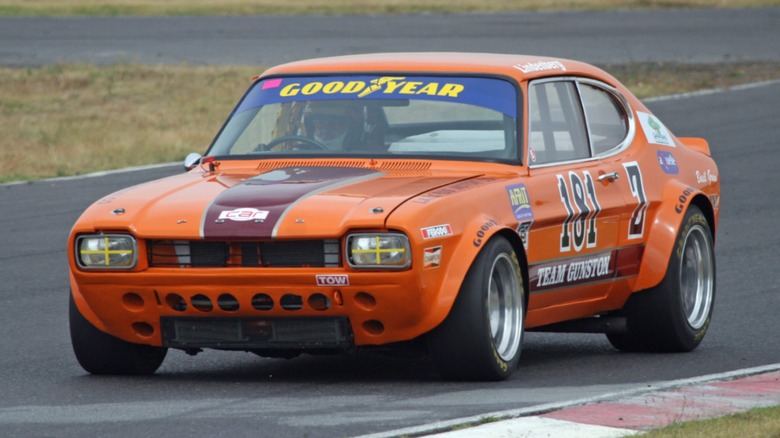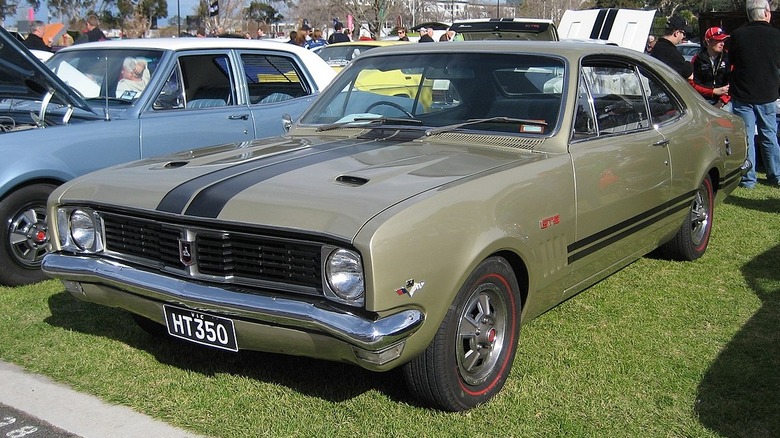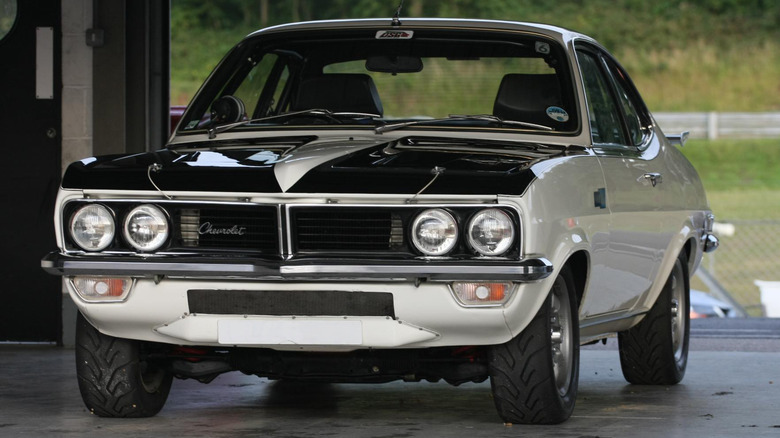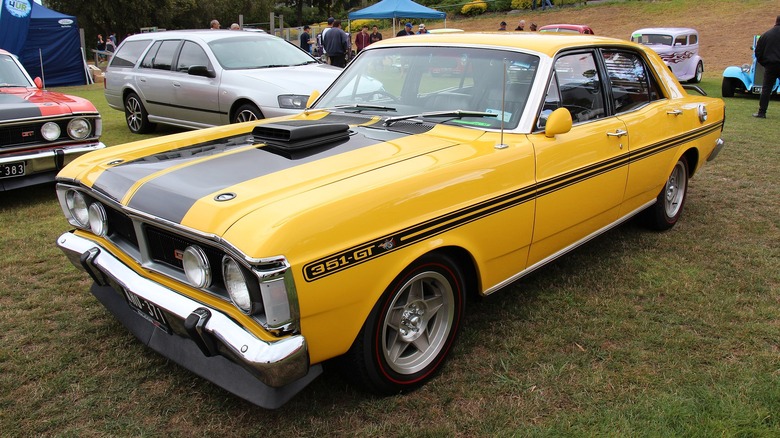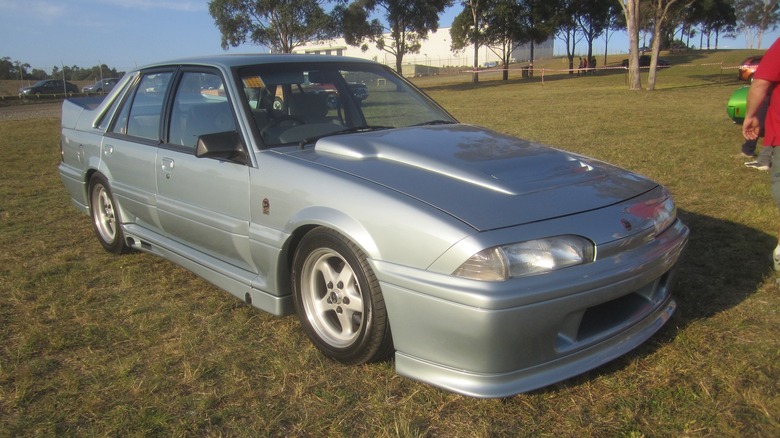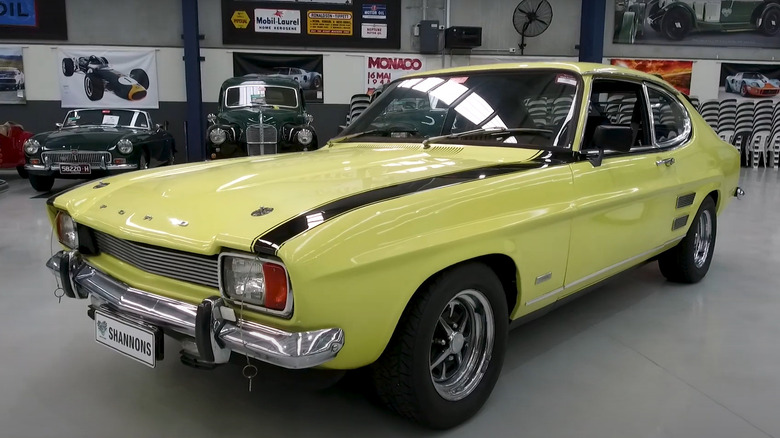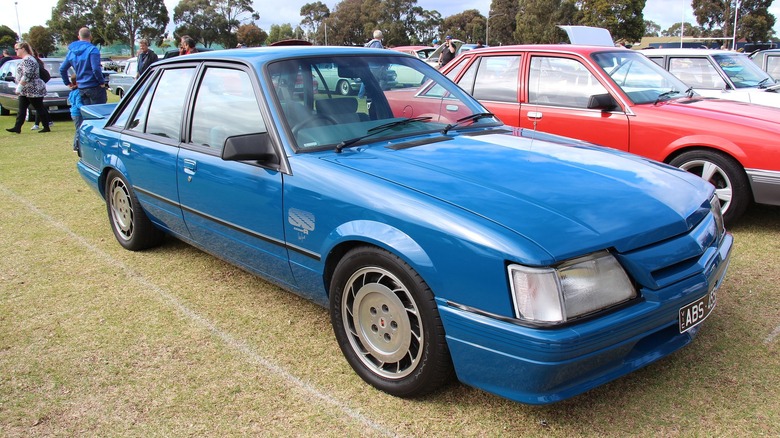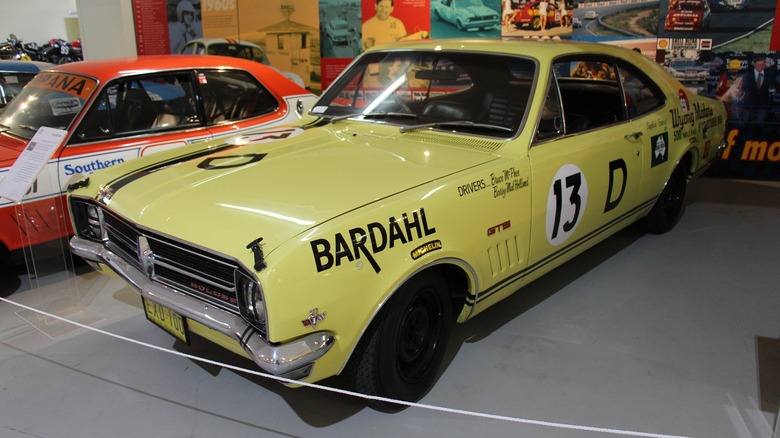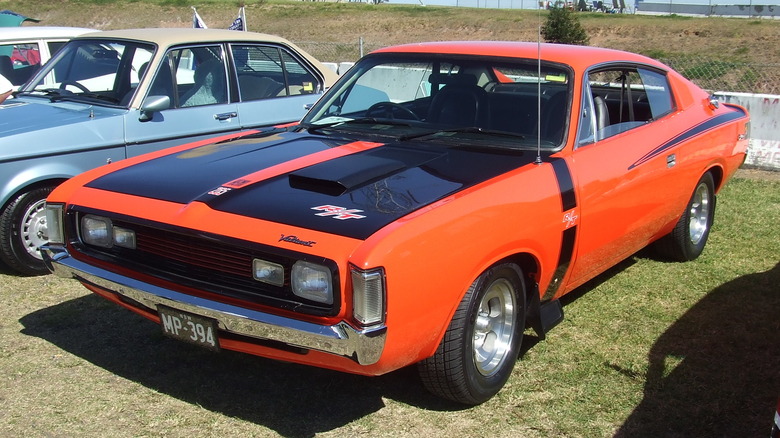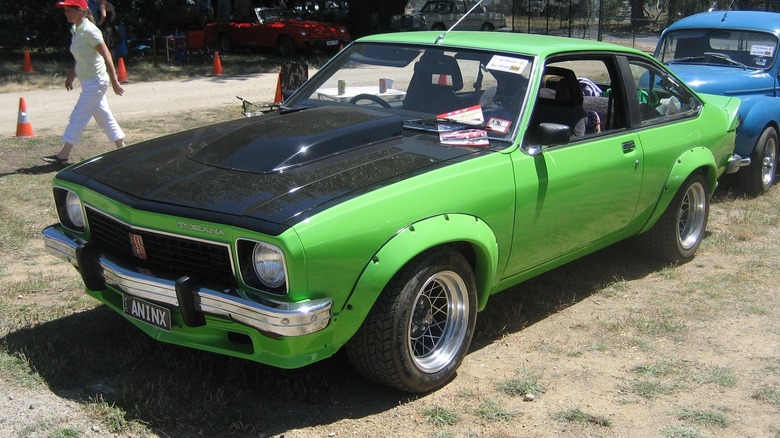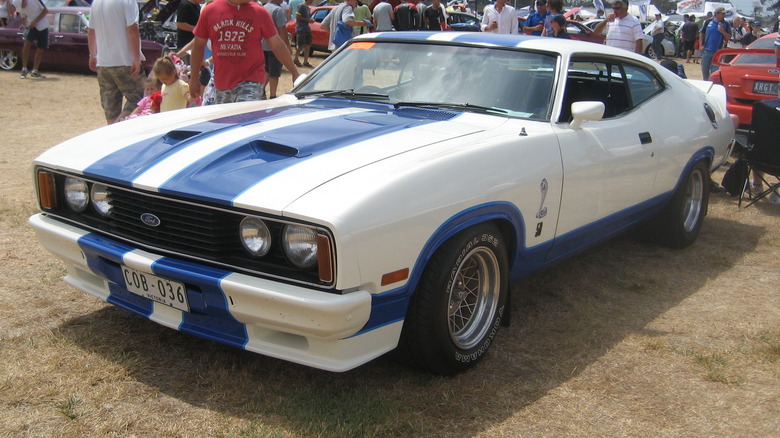10 Classic Muscle Cars That Were Never Sold In America
Muscle cars are among the most sought-after classics in America, with the rarest and most pristine examples fetching millions of dollars at auction. However, actually defining what qualifies as a muscle car is not as easy as it might seem to be at first. Even dictionaries give conflicting definitions — some claim muscle cars have to be American and only feature two doors, while others refer to vehicles made in the '60s that took inspiration from racing designs.
There's an argument to be made that none of those definitions accurately reflect the term, as alongside America, countries like Australia and South Africa had vibrant muscle car scenes for decades, churning out local specials in the same vein as their American counterparts — sometimes even long after America's muscle car scene began to wane.
While some purists out there will argue that muscle cars always have to be American, we've rounded up 10 classics from around the world that prove otherwise. Each one never made it to U.S. shores, but all remain highly sought-after in their respective home countries, with the most valuable even reaching seven figures at auction.
Holden HT Monaro GTS 350
Debuting in 1969, the Holden HT Monaro GTS 350 was designed to rival Ford's XW Falcon GTHO Phase I. It represented a significant boost in power over the outgoing HK Monaro GTS 327, making 300 horsepower thanks to the Chevrolet 350 cubic inch V8 under the hood. On the track, the GTS 350 was run by the newly-formed Holden Dealer Team (HDT) and debuted at the 1969 Bathurst 500 after Holden scored its first major racing win at the previous year's event. The '68 running had seen Holdens take all three steps of the podium — unseating previous favorites Ford — which meant that expectations were high for '69.
The team and the car delivered on those hopes, winning the race and following it up with a win at Surfers Paradise the next year. The late '60s were a particularly transformative few years for Holden's performance car division — its most powerful Monaro in '67 only made 145 horses, but by the time the GTS 350 launched less than two years later, that figure had more than doubled.
[Featured image by Sicnag via Wikimedia Commons | Cropped and scaled | CC BY 2.0]
Chevrolet Firenza Can-Am
Another muscle car built as the result of a racing rivalry, the Chevrolet Firenza Can-Am took the chassis and bodyshell of a small British car and squeezed in a big American V8 engine. Rather than Australia, however, it was South Africa where the Firenza Can-Am originated. It was created by Basil Van Rooyen, a local racing star who designed it as a homologation special to meet Production Car Championship requirements. Originally, Van Rooyen had planned to use an Australian-built Holden V8, but since those were too big to meet the regulations, he snagged a batch of 302 cubic inch V8 engines that were destined for use in the American Camaro Z/28 instead.
The Firenza, in its base form, was a small car powered by a weedy 1.2L four-cylinder, so fitting a 302 V8 produced transformative results. The Can-Am is far from the easiest car to drive –- it can reach 100 mph in second gear and spins its wheels the whole way there -– but it was exactly what Van Rooyen was looking for. A limited run of 100 examples were produced to meet homologation requirements, but unfortunately the car's racing career was cut short. The 1973 oil crisis meant that racing was temporarily suspended across South Africa, so just a year after it debuted, the Firenza Can-Am was forced into retirement.
[Featured image by Tony Harrison via Wikimedia Commons | Cropped and scaled | CC BY-SA 2.0]
Ford XY Falcon GT-HO Phase III
The Ford XY Falcon GT-HO Phase III was a record breaking car when it was released and remains a record breaker today — albeit in an entirely different sense. Built, like so many other great Australian muscle cars, for racing at Bathurst, the Phase III was considered to be the fastest four-door car in the world when it was released in 1971.
Officially, Ford claimed that the Phase III had only seen minor tweaks and upgrades over the preceding Phase II and that its power output was the same at 300 horsepower. However, this was likely a ploy by Ford to avoid revealing the car's true power before the all-important race –- journalists at the time claimed a realistic output of 380 horsepower.
It was powered by a 351 cubic inch Cleveland V8, and could officially reach 142 mph. Aside from being simply faster, Ford's engineers had refined the Phase III to be easier to drive at lower speeds than the outgoing model. Its status as a world-beating four-door, combined with its decisive win at Bathurst in 1971, has made it one of the most valuable Australian cars ever built. A low-mileage example appeared for sale in 2022 for $1.2 million AUD (around $800,000 USD), but a private sale of an ultra-rare Phase IV car reportedly exceeded $1.75 million AUD ($1.18 million USD) the year before.
[Featured image by Sicnag via Wikimedia Commons | Cropped and scaled | CC BY 2.0]
HSV VL SS Group A Walkinshaw
The Walky, as it was commonly known, was developed at a key point in Holden's racing history. The Holden Dealer Team, previously responsible for the brand's competition success, had been dumped by Holden after team owner Peter Brock went on a sudden, bizarre media tour touting the transformative power of healing crystals on his cars' performance. Faced with the PR nightmare of explaining why its race team boss was now ranting about performance-enhancing rocks, Holden bosses went looking for other companies with which it could build competition cars.
Tom Walkinshaw Racing was chosen as the brand's new partner, with the new racing outfit christened Holden Special Vehicles, or HSV. The VL SS Group A Walkinshaw was its first product and was most notable for its unique, squared-off aero kit that made it stand out from anything else on the road. Originally, 500 examples of the car were planned to satisfy homologation rules, but in the wake of strong demand, an extra 250 units were later built.
The car's 241 horsepower wasn't exceptional even back then, and it proved largely unsuccessful in racing. Nonetheless, the torquey, specially-developed 5.0L (304 cubic inch) V8 was great at shredding the car's skinny tires, and its unique looks have ensured it remains a cult classic among collectors today.
[Featured image by Sicnag via Wikimedia Commons | Cropped and scaled | CC BY 2.0]
Ford Capri Perana V8
South Africa's '70s muscle car scene owes a lot to men named Basil. There was Basil Van Rooyen creating the mad Firenza Can-Am for Chevrolet, while on the other side of the age-old rivalry, Basil Green was tasked with creating locally-brewed muscle for Ford. Green's recipe featured similar ingredients to that of Van Rooyen: take a small European coupe — this time a Ford Capri — and wedge a V8 in the engine bay.
The result was the Capri Perana V8, a race-ready muscle car that was produced in roadgoing form to meet homologation requirements. In fact, the V8 Ford pre-dates the Chevy by a couple of years as the Perana V8 was unveiled in 1970 and went on to dominate racing that year by winning 13 out of 14 races it competed in.
The car's chassis and bodyshell were built at Ford's South African facility and then shipped to Basil Green Motors for the engine and transmission to be installed. Buyers could order one through a standard Ford dealer, complete with a factory-backed warranty, and it's thought that around 500 examples were made altogether. The few that survive today are almost all still in South Africa, although at least one example is known to have been exported to the U.K.
HDT VK SS Group A
One of the most famous cars built by Peter Brock's HDT, the VK SS Group A featured a 304 cubic inch V8 developed specifically for competition and then adapted for the road. It was built to homologate HDT's race car for Group A regulations, so a total of 500 were planned to be constructed. However, according to HDT, a mixup in numbering meant that 502 examples were actually built, all as 1985 models.
Every example was finished in the same shade of Formula Blue paint, which led race fans to nickname the car the Blue Meanie. Thanks to a set of upgrades including an upgraded block, roller rockers, and a new exhaust, the car produced around 270 horsepower. That power was sent to the ground through either a standard four-speed or optional five-speed manual transmission. Inside, the car was fitted with extras including sports seats and a Momo steering wheel to emphasize that this was no run-of-the-mill family sedan.
[Featured image by Sicnag via Wikimedia Commons | Cropped and scaled | CC BY-SA 4.0]
Holden HK Monaro GTS 327 Bathurst
The predecessor to the legendary HT Monaro GTS 350, the HK Monaro GTS 327 was responsible for Holden's first Bathurst win in 1968. Equipped with a 327 cubic inch V8 engine making 250 horsepower, the car took all three top places in the race, immediately cementing it as one of the most collectible Holdens ever made. As a result, it's also one of the most valuable, with examples hovering around the $300-350,000 AUD ($200-235,000 USD) mark.
The car was officially claimed to make the sprint to 62 mph from a standstill in 7.6 seconds on its way to a top speed of 125 mph. However, that was proved to be inaccurate –- in fact, it was capable of much higher speeds, at least in full race-spec form.
However, the 1968 victory, with Holden Dealer Racing Team's Bruce McPhee at the wheel, wouldn't have happened were it not for the rival Fords suffering a run of bad luck throughout the race. In fact, with only a few laps to go, a Ford was still in front of McPhee, but it picked up damage and was forced to retire at the last minute. That handed Holden the win, helping to crank up the rivalry between the two teams while setting the stage for Australia to deliver some of its most iconic muscle cars in the following years.
[Featured image by Sicnag via Wikimedia Commons | Cropped and scaled | CC BY 2.0]
Chrysler Valiant VH Charger E49 R/T
Ford and GM-backed Holden weren't the only two manufacturers to be duking it out in the Australian muscle car scene. Chrysler's Aussie division also got in on the action, although its most famous creation stretched the definition of what some people would consider a muscle car. Instead of a V8 under the hood, there sat a 4.3L (262 cubic inch) inline-six. It might have been lacking a pair of cylinders, but its performance was inarguable — 0-60 mph in 6.1 seconds and a standing quarter mile in the mid-14 second range.
Although it might have been faster on the road, the Valiant VH Charger E49 R/T never quite saw the same successes as its rivals on the track. It debuted at Bathurst in 1972, managing a best of third. A Holden and a Ford beat it to the top spots. Despite this, it has still become a very valuable collectors' classic in the decades since, with prices for the best examples eclipsing more than a quarter of a million USD.
[Featured image by Jeremy via Wikimedia Commons | Cropped and scaled | CC BY 2.0]
Holden Torana A9X
With only 100 examples produced, the Holden Torana A9X is one of the rarest Aussie muscle cars as well as one of the most desirable. It was created to homologate changes requested by Holden Dealer Team, including a new differential, the distinctive hood scoop, and improved brakes. The road version of the A9X was only ever designed to tick the box so HDT could go racing, and as a result, it's not an easy car to drive around town. In fact, it's not easy to drive at road legal speeds at all -– it can do over 70 mph in first gear.
Nonetheless, it gave Peter Brock the all-clear to compete in the Australian Touring Car championship, and the car proved to be extremely capable on the track. It won on its debut in 1977, and two years later it made history at Bathurst by taking the checkered flag a staggering six laps ahead of its nearest rival.
[Featured image by Sicnag via Wikimedia Commons | Cropped and scaled | CC BY 2.0]
Ford XC Falcon Cobra
The Cobra moniker is most famously associated with Mustangs and Caroll Shelby's iconic AC Cobra in America. However, over in Australia, another local legend also bore the name — the Ford Falcon.
The XC Falcon Cobra was reportedly conceived as a way of selling old bodyshells at the end of the XC Falcon's production run but was marketed at the time as a celebration of Ford's racing success at Bathurst. In 1977, two Ford Falcons had crossed the finish line of the famous race in first and second, and so the following year, the XC Falcon Cobra was unveiled to commemorate the win.
There were 400 Falcon bodyshells spare, and so it was decided that 400 examples of the Cobra would be built. Of those, 30 were given further upgrades and marketed as the Bathurst Specials. Under the hood sat a 351 cubic inch Cleveland V8 making around 217 horsepower and 316 lb-ft of torque –- not as potent as the golden age muscle cars, but an impressive figure for the oil crisis years.
The Cobra's limited run, combined with its distinctive white and blue livery, has made it a highly collectible classic muscle car in Australia. Prices vary considerably based on options, mileage, and condition, but buyers can expect to pay the equivalent of at least $100,000 USD, rising to more than $350,000 USD ($550,000 Australian dollars) for the most sought-after examples.
[Featured image by Sicnag via Wikimedia Commons | Cropped and scaled | CC BY 2.0]
